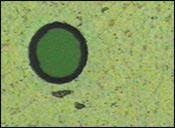CO2 processing at 9 microns
By Stephen Lee
Shorter wavelengths yield big results in materials processing
A large amount of materials processing is done using CO2 lasers operating in the mid–infrared (IR) spectrum. Their high efficiency and tremendous power output have made them one of the most useful lasers for materials processing. The CO2 laser's most commonly known transition wavelength at 10.6 microns facilitates laser cutting, drilling and marking of a wide variety of materials in the electronics and medical industries. However, many materials have even better absorption at shorter wavelengths in the range of 9.2 to 9.6 microns. In fact, some material's absorption is so much better at these shorter wavelengths that material processing in this part of the spectrum significantly speeds up processing time while decreasing thermal and collateral damage. The CO2 laser's versatility allows it to operate in this part of the spectrum providing an even more efficient material processor.
Material behavior at 9 microns
CO2 lasers cut, drill and mark materials by vaporizing the material through a process of vibrational bond–breakage called photothermal ablation. The efficiency of the photothermal ablation process is highly dependent upon the absorption of the material. Materials, because of their inherent physical and chemical properties, absorb light differently at different wavelengths. Less absorptive materials require longer dwell times that can cause substantial thermal damage or smaller thermal "wrinkles" in the surrounding material while leaving a lot of debris. The non–tenacious debris created by photothermal ablation typically is removed by conventional cleaning techniques like permanganate de–smearing.
Two common types of materials used extensively in the electronics and medical industry are polyimide and silicone. Polyimide is a synthetic polymer resin typically coated on copper substrates that is resistant to high temperature, wear and corrosion. It is used extensively in the electronics industry for flex circuits and printed wire boards. Although CO2 lasers can ablate polyimide, they cannot ablate copper because copper reflects light in the mid–IR. Additional etching or oxidizing processes are needed to cut or drill copper. Silicone is a family of semi–organic polymers that are inert and exhibit stable thermal properties. Silicone micro–tubes are used in a wide variety of applications, most notably in the medical industry for applications such as angioplasty.
Many, but not all, organic and semi–organic compounds are more conducive to material processing in the 9–micron region than the 10–micron region. A plastic's susceptibility to material processing is dependent upon its absorption. For example, Figure 1 illustrates the absorption of polyimide. At 10.6 microns the transmission of polyimide is approximately 70 percent while at 9.2 microns it is approximately 25 percent. Sil icone, by comparison, has a transmission of 91 percent at 10.6 microns and a transmission of 17 percent at 9.4 microns. Because polyimide and silicon have larger absorption at 9.2– and 9.4–micron wavelengths, respectively, they re quire less processing time, which results in less thermal and collateral damage to surrounding areas.
A variety of options
The versatility of the CO2 laser has made it the workhorse for cutting, drilling and marking applications ranging from prototyping to full production. CO2 laser drilling systems account for approximately 80 percent of the microvia drilling market, which continues to grow. Users have a wide variety of CO2 lasers to choose from depen ding upon the optimum application wavelength and power.
Coherent, for ex ample, manufactures a variety of models in 9–micron versions of the Diamond family of CO2 lasers. These lasers are specifically designed to efficiently process materials like polyimide, silicone and other plastics by exploiting their higher absorption in the 9–micron region. These lasers also can quickly and efficiently process a wide variety of other materials like ceramics, resin–epoxy mixes, glass and metals using fast pulse rise times and high peak powers.
The GEM series lasers are sealed, RF–excited, diffusion–cooled, waveguide technology CO2 lasers, and the GEM Q–400 is the world's first and only commercially available industrial sealed Q–switched CO2 laser. This laser is designed for precision and high–quality machining of thin non–metals while introducing almost no thermal damage to surrounding areas. Output power for the GEM series ranges from 100 W to kilowatts of peak power. The low–cost 100 W at 100–KHz version is ideal for cutting silicone tubing, scribing ceramic, fusing glass fibers and engraving wood.
The Ki series lasers are based on the sealed, diffusion–cooled slab geometry with output of 125 W and 225 W and are ideal for cutting and percussion drilling of polyimide. These lasers have microvia form ing speeds of 450 microvias per second.
Effective applications
Operation at optimum wavelengths and powers will remove material more efficiently, but not necessarily with good quality. Good quality is also a function of the laser's pulsing capability and beam quality. In Figure 2 a 9.4–micron laser was used to percussion drill 200–micron–diameter holes on the polyimide Kapton 300 HN, to observe the quality of such a drilled hole. Two small spots below the hole are attributed to scatter/ back reflection from the scanner set–up, which can be eliminated using proper stray light suppression techniques in production hardware. Table 1 lists the pertinent operating parameters used for the percussion drilling.
A second example of the quality of materials processing in the 9–micron region is demonstrated with a 9.25–micron laser galvo scanned beam used to skive polyimide from copper on a flex circuit board. The scanner was set to focus the laser beam 60 millimeters below the Y–axis of the scanner with a calculated focal spot size of 50 microns.
The scanner was configured to produce a rastered rectangle. Tests were made using various combinations of scan speed, pulse duration, pulse repetition rate, and scan line spacing to determine the optimum operating parameters, which are listed in Table 2.
No charring was observed, as is illustrated in Figure 3. The polyimide was successfully removed from large areas as well as copper leads and places where circuit patterns are located. Further more, clean remov al of polyimide from the flex circuitry was accomplished without additional cleaning.
Summary
Traditionally, CO2 lasers operating at 10.6 microns have been the workhorses for processing a wide variety of materials. How ever, shorter processing times, which translate into less thermal and collateral damage to surrounding areas, can be achieved by shifting to a shorter processing wavelength to exploit many materials' higher absorption in the 9–micron region. Nine–micron materials processing of polyimide and silicon used in the electronics and medical industries allows faster and more efficient flex circuit machining, plastics micromachining, microvia formation in printed circuit boards and cutting of silicone tubes. The CO2 laser's versatility allows it to operate in this part of the spectrum too, where it provides an even more efficient material processor.
Stephen Lee is CO2 product manager for Coherent Photonics Group, Laser Division, Santa Clara, CA. Contact him at tel. (408) 764–4663 or via e–mail at [email protected].
References
1. Sri Venkat, "The meteoric growth of laser microvias," Printed Circuit Europe, 3rd Quarter 2001.





